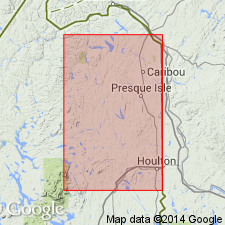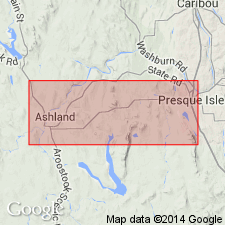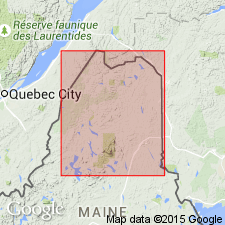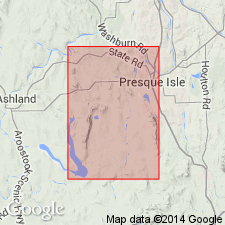
- Usage in publication:
-
- Sheridan sandstone
- Modifications:
-
- Original reference
- Dominant lithology:
-
- Sandstone
- AAPG geologic province:
-
- New England province
Summary:
Pg. 21, 45, 47-49, 51. Sheridan sandstone. Is a peculiar rock, looking like an ordinary sandstone of various degrees of fineness and in its coarsest state a pebbly conglomerate. Color greenish gray to rather dull brown. When closely inspected it is found to be composed of soft and hard rocks, both rounded and angular --quartz and feldspar; jasper, slate, and argillaceous shale, green, red, and black; and fragments of fossils, corals, and crinoids, but particularly pieces of brachiopods of size large enough to recognize. Most conspicuous feature is the angular pieces of black slate, which at first suggest fragments of carbonaceous matter but are evidently fragments of the more ancient slates. Igneous materials also are associated with them, emphasizing their close association in origin with the tuffs and volcanic ash beds with which they are stratigraphically associated. Believed to be about the same age as Ashland shales and older than Ashland limestones. Fauna presents affinities with both Clinton and Niagara of New York. Is regarded as younger than Aroostook limestone. Age is Silurian.
Named from exposures on Sheridan Plantation, south of Aroostook River, Aroostook Co., northeastern ME.
Source: US geologic names lexicon (USGS Bull. 896, p. 1983).

- Usage in publication:
-
- Sheridan sandstone
- Modifications:
-
- Age modified
- AAPG geologic province:
-
- New England province
Summary:
Pg. 172-173, 174. Sheridan sandstone. Stratigraphic revision. Unit now considered younger than shales and limestones of Ashland formation. Age is Silurian.
Source: US geologic names lexicon (USGS Bull. 1200, p. 3574).

- Usage in publication:
-
- Sheridan sandstone
- Modifications:
-
- Not used
- AAPG geologic province:
-
- New England province
Summary:
Pg. 8, 9. Sheridan sandstone. Name not used; preoccupied by a Precambrian unit in Yellowstone National Park.
Source: US geologic names lexicon (USGS Bull. 1200, p. 3574).

- Usage in publication:
-
- Sheridan formation†
- Modifications:
-
- Abandoned
- AAPG geologic province:
-
- New England province
Summary:
Pg. 16 (table 2), 31-33, pl. 1. †Sheridan formation. Authors propose name Frenchville formation to replace Williams' and Gregory's (USGS Bull. 165, 1900) Sheridan sandstone (preoccupied).
[See also entry under Frenchville.]
Source: Exerpted from US geologic names lexicon (USGS Bull. 1350, Frenchville entry p. 275).
For more information, please contact Nancy Stamm, Geologic Names Committee Secretary.
Asterisk (*) indicates published by U.S. Geological Survey authors.
"No current usage" (†) implies that a name has been abandoned or has fallen into disuse. Former usage and, if known, replacement name given in parentheses ( ).
Slash (/) indicates name conflicts with nomenclatural guidelines (CSN, 1933; ACSN, 1961, 1970; NACSN, 1983, 2005, 2021). May be explained within brackets ([ ]).

